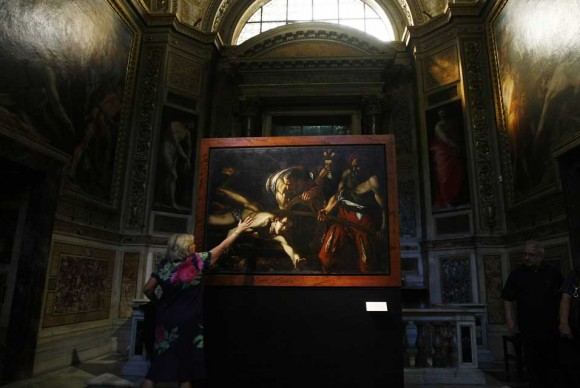Painting at Center of Caravaggio Mystery Unveiled in Rome
July 28, 2010 by All Art News
Filed under Education & Research
ROME (AP).- Art officials on Tuesday unveiled the painting at the center of the latest Caravaggio mystery, after the Vatican newspaper first suggested and then denied that the canvas was the work of the Italian master.
The “Martyrdom of St. Lawrence” will now be subjected to X-rays and other analyses to ascertain its attribution. But art officials and scholars attending the unveiling agreed the painting did not look like a Caravaggio — but rather like the work of one or more of his followers.
“It’s a very interesting painting but I believe we can rule out — at least for now — that it’s a Caravaggio,” said art superintendent Rossella Vodret. “The quality of the painting doesn’t hold up.”
Vodret theatrically opened the curtain on the painting in a Jesuit church in Rome, revealing a canvas dominated by the figure of the St. Lawrence being grilled to death, his three executioners in the backdrop.

Art superintendent Rossella Vodret illustrates some detail of the painting at the center of the latest Caravaggio mystery, after the Vatican newspaper first suggested and then denied that the canvas was the work of the Italian master, in Rome, Italy, Tuesday, July 27, 2010. The "Martyrdom of St. Lawrence" would now be examined to ascertain its attribution, but Vodret and other Caravaggio scholars attending the unveiling agreed the painting did not look like a Caravaggio, but rather like the work of his followers. They said the quality did not hold up to Caravaggio's standards. AP Photo/Pier Paolo Cito
The 183-by-130.5 centimeter (72-by-51 inch) painting was recently cleaned up and features the dramatic chiaroscuro typical of Caravaggio and his school. The painting will not be on public display.
The Vatican newspaper, L’Osservatore Romano, set the art world aflutter last week with a front-page article headlined “A New Caravaggio.”
The article made clear that no certain attribution had been made and that further tests were required. But the definitive-sounding headline and the fact that the claim was made on the day marking the 400th anniversary of the master’s death had raised expectations. The Vatican has in the past announced such art-world news in L’Osservatore, sometimes coinciding with an anniversary.
But on Monday, the newspaper reversed itself and published an article by the Vatican’s top art historian shooting down the claim. Under the front-page headline “A New Caravaggio? Not really,” Vatican Museums chief Antonio Paolucci wrote that the work was not of Caravaggio’s quality and termed it “modest” at best.
The painting belongs to the Jesuit order and had been kept for years in a private room in the Chiesa del Gesu in Rome, said the church’s rector, the Rev. Daniele Libanori. As the painting’s cleanup this year revealed an interesting work, art officials were called in.
But Libanori said the original claim in L’Osservatore came as a surprise to the Jesuits, too.
Mystery still surrounds the history of the canvas. Libanori was secretive about its origin, declining to say what city or Jesuit venue the painting had come from.
The painting is uneven artistically, scholars said, with some beautiful elements and some parts they didn’t hesitate to call “very poor” and even “embarrassing.” This suggested that two different people may have worked at it, though it is not certain.
Vodret said the most interesting element is the position and perspective of the saint, who’s shown on the grill, one arm extended, his figure lit up. Such unique iconography might have suggested the hand of Caravaggio, known for showing scenes as if shot from unusual angles.
She said the hand of one of the executioners, holding a stick to keep the saint down, is also of good quality. But she and the other experts noted that elements were poor, such as the bodies of the executioners, the cloth covering Lawrence, and one of the saint’s legs, which appears to be awkwardly attached to the torso.
“The leg looks like a frog’s leg. Caravaggio would never have made such a mistake,” said Marco Bona Castellotti, an art historian. Even as he saw the painting for the first time at Tuesday’s unveiling, he had no doubt it couldn’t be Caravaggio.
Experts believed the work may have been done by a follower, likely in Naples, Sicily or Malta — all places where the painter spent time during his tumultuous life. Caravaggio died in a Tuscan coast town in 1610 in mysterious circumstances, and a group of Italian researchers said recently that they had identified his remains.
The tests on the “Martyrdom of St. Lawrence” will begin in September, accompanied by research of archives and documents in order to trace the history of the painting and who commissioned it. The research will take several months.
